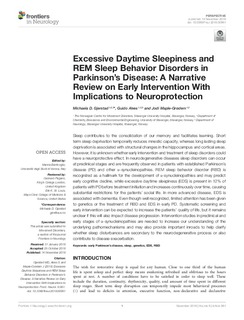| dc.contributor.author | Gjerstad, Michaela D | |
| dc.contributor.author | Alves, Guido Werner | |
| dc.contributor.author | Maple-Grødem, Jodi | |
| dc.date.accessioned | 2019-08-22T07:48:38Z | |
| dc.date.available | 2019-08-22T07:48:38Z | |
| dc.date.created | 2018-12-27T14:08:42Z | |
| dc.date.issued | 2018-11 | |
| dc.identifier.citation | Gjerstad, M.D., Alves. G.W., Maple-Grødem, J. (2018) Excessive Daytime Sleepiness and REM Sleep Behavior Disorders in Parkinson's Disease: A Narrative Review on Early Intervention With Implications to Neuroprotection. Frontiers in Neurology, 9:961 | nb_NO |
| dc.identifier.issn | 1664-2295 | |
| dc.identifier.uri | http://hdl.handle.net/11250/2609745 | |
| dc.description.abstract | Sleep contributes to the consolidation of our memory and facilitates learning. Short term sleep deprivation temporarily reduces mnestic capacity, whereas long lasting sleep deprivation is associated with structural changes in the hippocampus and cortical areas. However, it is unknown whether early intervention and treatment of sleep disorders could have a neuroprotective effect. In neurodegenerative diseases sleep disorders can occur at preclinical stages and are frequently observed in patients with established Parkinson's disease (PD) and other α-synucleinopathies. REM sleep behavior disorder (RBD) is recognized as a hallmark for the development of α-synucleinopathies and may predict early cognitive decline, while excessive daytime sleepiness (EDS) is present in 12% of patients with PD before treatment initiation and increases continuously over time, causing substantial restrictions for the patients' social life. In more advanced disease, EDS is associated with dementia. Even though well recognized, limited attention has been given to genetics or the treatment of RBD and EDS in early PD. Systematic screening and early intervention can be expected to increase the patients' quality of life, but it remains unclear if this will also impact disease progression. Intervention studies in preclinical and early stages of α-synucleinopathies are needed to increase our understanding of the underlying pathomechanisms and may also provide important inroads to help clarify whether sleep disturbances are secondary to the neurodegenerative process or also contribute to disease exacerbation. | nb_NO |
| dc.language.iso | eng | nb_NO |
| dc.publisher | Frontiers Media S.A. | nb_NO |
| dc.rights | Navngivelse 4.0 Internasjonal | * |
| dc.rights.uri | http://creativecommons.org/licenses/by/4.0/deed.no | * |
| dc.subject | nevrologi | nb_NO |
| dc.subject | Parkinson's | nb_NO |
| dc.subject | Parkinson | nb_NO |
| dc.subject | søvnforstyrrelser | nb_NO |
| dc.title | Excessive Daytime Sleepiness and REM Sleep Behavior Disorders in Parkinson's Disease: A Narrative Review on Early Intervention With Implications to Neuroprotection | nb_NO |
| dc.type | Journal article | nb_NO |
| dc.type | Peer reviewed | nb_NO |
| dc.description.version | publishedVersion | nb_NO |
| dc.rights.holder | © 2018 Gjerstad, Alves and Maple-Grødem. | nb_NO |
| dc.subject.nsi | VDP::Medical disciplines: 700::Clinical medical disciplines: 750::Neurology: 752 | nb_NO |
| dc.source.pagenumber | 6 | nb_NO |
| dc.source.volume | 9 | nb_NO |
| dc.source.journal | Frontiers in Neurology | nb_NO |
| dc.identifier.doi | 10.3389/fneur.2018.00961 | |
| dc.identifier.cristin | 1647405 | |
| cristin.unitcode | 217,8,10,0 | |
| cristin.unitname | Institutt for kjemi, biovitenskap og miljøteknologi | |
| cristin.ispublished | true | |
| cristin.qualitycode | 1 | |

